|
The Picture Palace
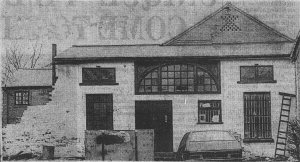 Farndon once had its own cinema, which operated continuously from 1923 until the late 1950s. The old cinema was built in 1922 by Thomas Roycroft and was operated and managed by himself and his family.
(Right: The Picture Palace photographed in the 1970s, with a glimpse of the schoolhouse to the left. Click to enlarge. )
Mr Roycroft was quite a character. Born in 1877 in Huxley, Cheshire, where his father worked as a 'castrator' (a vet), the family moved around the rural farming area of Tarporley-Bunbury, until he married Agnes c.1899 and they moved to a cottage in Wrenbury wher he carried on his father’s practice. It seems his career ambitions lay elsewhere however, as by the early 1900s, the young family had relocated to a terraced house at 8 Park Street, in Liscard, Wallasey, where he worked as an electrical engineer. One of his contracts was to install the first X-Ray equipment in Wallasey Hospital.
On what was to be his final move, the family settled in Bridge View on Farndon High Street in 1912 (next door to The Greyhound), acquiring a former farm with a small academy in its grounds. This academy was known as Brown’s Academy for Young Gentlemen, which was in operation in the second half of the nineteenth century, although with the advent of free education in the 1870s, this establishment, along with others in the village, closed, and it became a private residence, still known today as the Old Schoolhouse (pictured above in the roll-over image).
Farndon once had its own cinema, which operated continuously from 1923 until the late 1950s. The old cinema was built in 1922 by Thomas Roycroft and was operated and managed by himself and his family.
(Right: The Picture Palace photographed in the 1970s, with a glimpse of the schoolhouse to the left. Click to enlarge. )
Mr Roycroft was quite a character. Born in 1877 in Huxley, Cheshire, where his father worked as a 'castrator' (a vet), the family moved around the rural farming area of Tarporley-Bunbury, until he married Agnes c.1899 and they moved to a cottage in Wrenbury wher he carried on his father’s practice. It seems his career ambitions lay elsewhere however, as by the early 1900s, the young family had relocated to a terraced house at 8 Park Street, in Liscard, Wallasey, where he worked as an electrical engineer. One of his contracts was to install the first X-Ray equipment in Wallasey Hospital.
On what was to be his final move, the family settled in Bridge View on Farndon High Street in 1912 (next door to The Greyhound), acquiring a former farm with a small academy in its grounds. This academy was known as Brown’s Academy for Young Gentlemen, which was in operation in the second half of the nineteenth century, although with the advent of free education in the 1870s, this establishment, along with others in the village, closed, and it became a private residence, still known today as the Old Schoolhouse (pictured above in the roll-over image).
He soon capitalised on his electrical engineering skills and produced the first electricity in the village by the use of a combination of gas from the local gas works, generators, and wet batteries. Several of the larger houses had this installed, and soon after this, Thomas Roycroft negotiated with the then Electricity Company in Chester to bring the mains supply from their generating plant to Farndon, which benefitted other communities along the supply route.
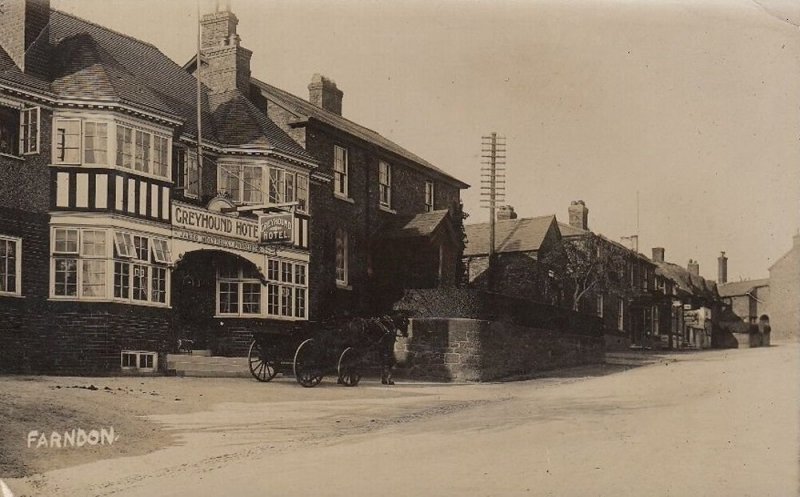
The Greyhound and Bridge View 1920s / The Hare and Bridge View (modern)
(Roll mouse over image to compare views)
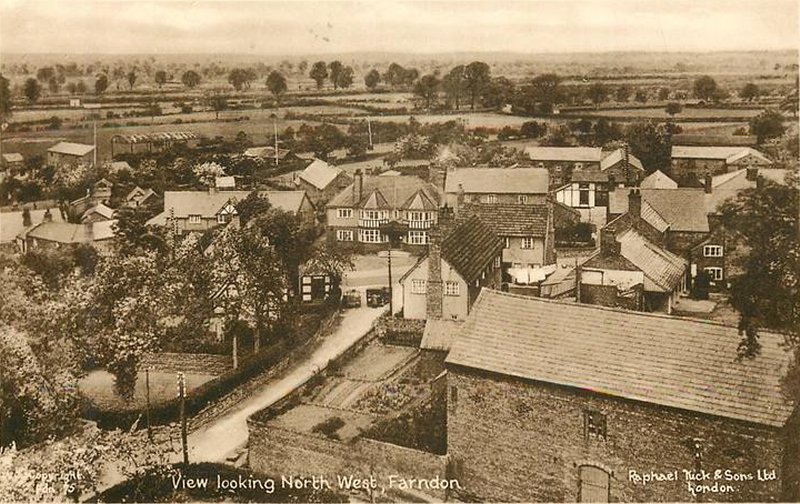 The Greyhound and Bridge View 1920s from the church tower(1950s)
The Greyhound and Bridge View 1920s from the church tower(1950s)
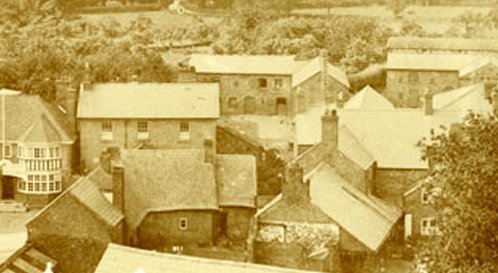
Bridge View and outbuildings, pre-cinema c.1910 / Bridge view and cinema c.1950 (white fascia boards)
Roll mouse over image to compare views
Thomas Roycroft then turned his focus to the subject of indoor entertainment, and in particular to silent films, with the intention of makinging them easily accessible to villagers. He created the Farndon Cinema or 'The Picture Palace' as he called it. Initially, it was housed in a building which later became a warehouse for industrial sewing machines, while he busily converted a range of farm buildings to the rear of his house. He then applied for a licence from the local Broxton Sessions Court which was granted in March 1923.
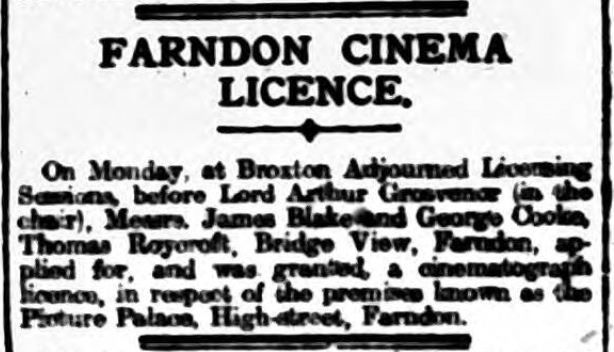 Licence application, Cheshire Observer, 10 March 1923
He was aided by his wife Agnes and daughters Florence and Pricilla, while Florence's husband Clucas Edward Quayle, whom she married in 1921, was the cinema electrician and operator. All the family resided in Bridge View, that is, until events took a sad turn at the end of the decade when Clucas was fatally hurt in a motorcycle accident in Shocklach and Thomas Roycroft passed away on 8 February 1931.
Licence application, Cheshire Observer, 10 March 1923
He was aided by his wife Agnes and daughters Florence and Pricilla, while Florence's husband Clucas Edward Quayle, whom she married in 1921, was the cinema electrician and operator. All the family resided in Bridge View, that is, until events took a sad turn at the end of the decade when Clucas was fatally hurt in a motorcycle accident in Shocklach and Thomas Roycroft passed away on 8 February 1931.
Faced with an uncertain future, it seems that the cinema was sold to Mr Edward Jarvis, who was already operating the Town Hall Cinema in Ellesmere, revealed in his application for the Farndon licence in 1932.
FARNDON CINEMA
An application was made by Mr Edward Jarvis, of the Town Hall Cinema, Ellesmere, for a licence for the Palace Cinema, Farndon. He stated that he was in possession of the premises. Supt. Morgan said the premises were suitably and properly constructed. The application was granted.
Cheshire Observer, 4 June 1932
|
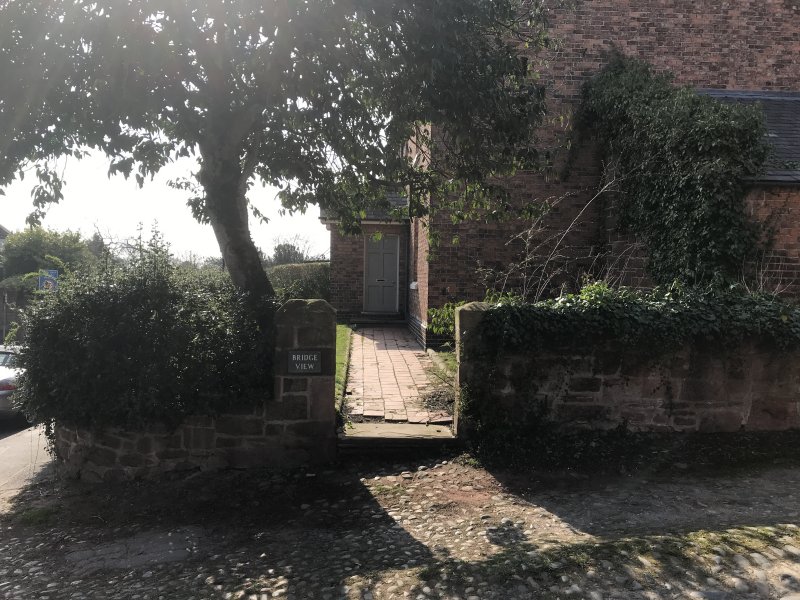
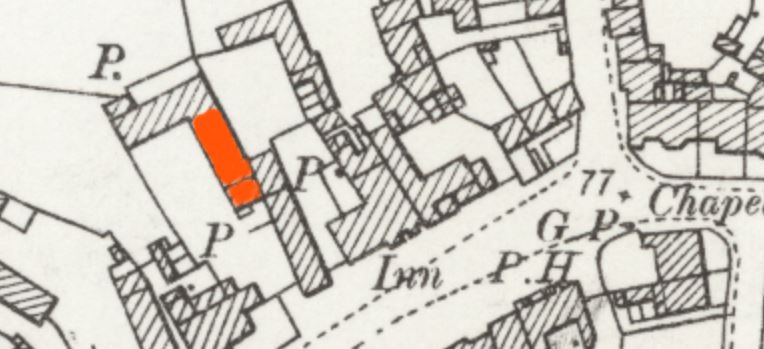 The location of The Picture Palace
The location of The Picture Palace
Four years later, it was leased by Robert Pickwick, who applied for a licence renewal in 1936.
FARNDON CINEMA LICENCE
An application was made by Mrs Agnes Wright, of Farndon, for the renewal of the Farndon Cinema licence, held by the tenant, Robert Henry Pickwick, who, it was stated, could not attend owing to illness.
Supt. Morgan: Mrs Wright says she is not at all sure the cinema is going to be carried on.
The Magistrates’ Clerk (Mr A. Matheson): The house is at present closed? - Mrs: Yes.
The Magistrates’ Clerk: The licence will be granted to the existing holder, seeing the police have no objection. Mrs Wright appears as his agent to obtain the licence.
Applicant said the cinema had only been closed since the end of the week.
The renewal was granted to the present licensee.
Cheshire Observer, 8 February 1936
|
Meanwhile, the Roycofts, still in Bridge View, continued to manage and operate the cinema throughout the unsettled thirties.
The 1939 census reveals;

Blanked out is Florence's son Lawrence Edward Kingston Quayle, born in 1923, and still at school
(The record of anyone born less than 100 years ago is closed unless they are known to have died).
Florence, her sister Priscilla, and Lawrence's older sister Gloria continued to work as 'cinema assistants'. Lawrence soon joined them and continued to run the Palace Cinema until it closed.
As well as showing films, repertory companies made live stage presentations at The Palace. One theatre company being owned by villager Mr Bradley-Dixon. Presentations of various kinds were made including the melodrama ‘Maria Marten – or Murder in the Red Barn,’ based on the 1935 British film, and a true story.
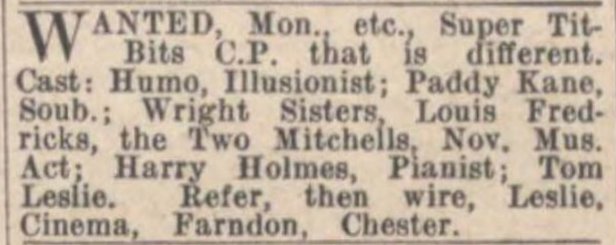
Advert in The Stage, 2 June 1932
On 28 April 1942, the licence changed hands again,
|
FARNDON CINEMA LICENCE
The licence of the Farndon Cinema was at Broxton Petty Session on Tuesday, transferred from Mr Edward Taylor to Miss Katherine Mary Walsh of 8 Waverley Terrace, Rossett.
The application was made by Mr Hugh C. Wickham, who said Miss Walsh already held the licence of the cinema at Rossett. At a future Court, after notice had been given, he would apply for a seven days licence for the cinema.
Chester Chronicle, 2 May 1942
|
Miss Walsh also intended to open the doors on Sundays for local film-goers, but this was a step too far for the local Sessions, who denied her application; (click for article from Chester Chronicle, 11 July 1942)

Nevertheless, it was particularly well patronised for children's matinees when it was run by the founder's grandson, Mr. Lawrence Kingston-Quayle, who also acted as projectionist. The cinema held about 100 people, who paid between 8d. and 1s /2d for admission (or 4d. to 1 /- for children). His sister, Miss Gloria Kingston-Quayle, also gave ballet lessons and formed the first Brownie pack.
The cinema eventually ceased operating in the late 1950s, but Lawrence and his family continued to live in Bridge View, while he earned his living as a photographer. Lawrence passed away in 1994 and his sister Gloria in 1976.
In 1986, plans were put in place to demolish the old cinema building to enable a new extension to be built on the residential Old Schoolhouse to the rear. A series of objections were raised, co-ordinated by Leslie Parker-Davies, who also wrote to the planning office in Chester Town Hall. The local press picked up the story;
FARNDON CINEMA TO BE RAZED?
Plans to demolish the historic Palace Cinema in Farndon have provoked opposition in the village.
Next Wednesday’s City Planning Committee will discuss proposals to knock down the cinema and build a bedroom and double garage onto the attached former schoolhouse.
Representations from villagers have already been received and local man Mr Leslie Parker-Davies, of Checkers, Barton Road, Farndon, has been quick to stress the building’s historical significance.
“I believe it to have been the first cinema in Cheshire to have regular presentations from the time of the silent films,” said Mr Parker-Davies.
The cinema was converted from a range of farm buildings by the late Thomas Roycroft early this century and it was in continuous use until the late fifties.
City director of technical services, Mr Cyril Morris, explained Council permission for the demolition was required because the cinema is in a conservation area.
Chester Observer, 19 March 1986
|
Leslie Parker-Davies, in his letter to the planning office in Chester Town Hall, described the importance of the building before concluding,
|
'The above is a brief factual account of the building which is the subject of the application. I feel, however, that these facts should be seriously taken into account before this monument to contemporary history is allowed to be demolished. The fact quoted in the press that the building is asbestos lined is really of no real significance, as all cinemas built pre-war were required to be so lined under the regulations of that period.
Whist not wishing to stand in the way of progress, that the foregoing facts ought to be considered and demolition is approved, should it not be conditional that due recognition of the site be made public for future generations?'
|
The objections were futile however, and all traces of the first cinema in Cheshire to have regular cinematograph presentations, from the time of silent films to the late 1950s, was removed.
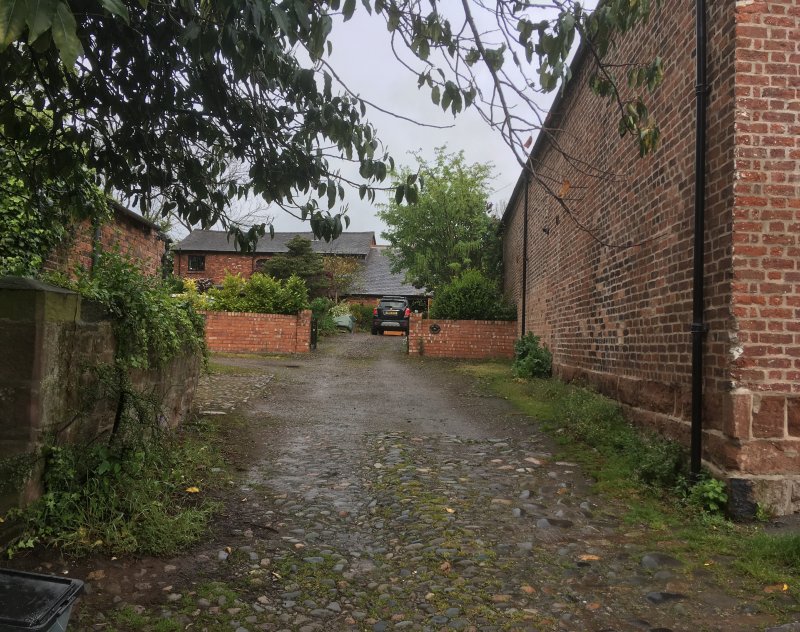
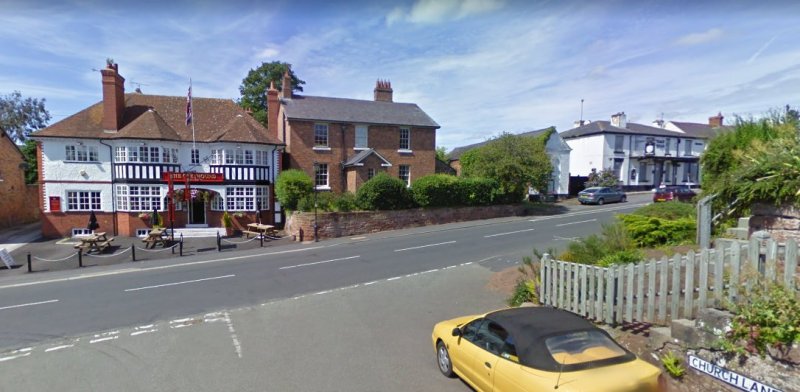
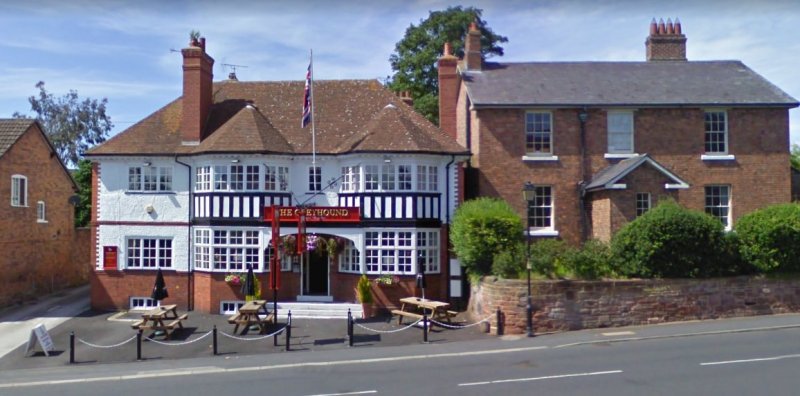
The Greyhound (now The Hare), and Bridge View
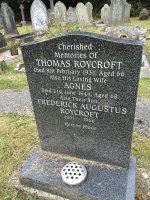 |
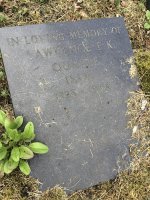 |
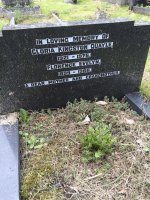 |
| Thomas Roycroft |
Lawrence Quayle |
Gloria Quayle |
The resting place of the Roycroft family, St Chad's Churchyard, Farndon (photos by Linda Griffiths)
|

